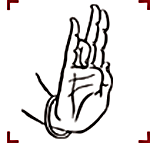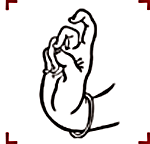![]()
![]()
(Gestures of single or non-combined hand)
Hastaabhinaya (Gestures of the Hands)
ANGUSTHA: THUMB FINGER
TARJANI: FORE FINGER
MADHYMA: MIDDLE FINGER
ANAMIKA: RING FINGER
KANISHTHA: LITTLE FINGER
![]()
“PATAKASTRIPATAKASCHA TATHA VAI KARTARIMUKHAHA ARDHACHANDRO HYARALASCHA SUKATUNDASTATHAIVA CHA MUSHTISCHA SIKHARASCHA KAPITHAHAKATAKAMUKHAHA SUCHIASYAH PADMAKOSHASCHA TATHA VAI SARPASIRSHAKAHA MRIGASIRSHAH PARO GNEYO HASTABHINAYAYOKTRIBHIHI LANGULO HELAPADMASCHA CHATURO BHRAMARASTATHA HAMSASYO HAMSAPAKSHASCHA SAMDAMSO MUKULASTATHA URNANABHA TAMRACHUDAHA CHATURVIMSADIME KARAHAâ€
![]()
There are 24 types of Asamyuta Hastas. They are :
| 1. Pataka | 13. Sarpasirsha |

![]()
![]()
 |
YASYANGULYO BHAVANTIHI KUNCHITASCHA TATHANGUSTHA SA PATAKA ITI SMRUTAHA |
![]()
Where all the fingers are extended, keeping them close to one another with the thumb bend, the gesture is called Pataka.
![]()
To describe cloud, Forest, River, Open doors, to beat, Natyaarambha (to start dance) etc.
 |
BHAVETPRUSHTHAVALOKINI TARJANI MADHYAMAYASCHA TADASAU KARTARIMUKHAHA |
In the Pataka hand the ring finger is kept bend this should be known Tripataka.
Crown, Tree, Vajrayudha, raising flames, lamb, arrow etc.
![]()
![]()
 |
YASYANGULYO BHAVANTIHI KUNCHITASCHA TATHANGUSTHA SA PATAKA ITI SMRUTAHA |
![]()
In the Tripataka hand if the index finger faces the back of the middle finger it is Kartarimukha.
![]()
Separation, corner of an eye, lightning.
![]()
![]()
![]()
 |
SAHANGUSTHENA CAPARAM SORDHACHANDRO HI VIGNEHAKARAH KARMASYA VAKSYATE |
![]()
The thumb is bent to outside, the rest of the fingers are brought together and the shape must be seen like a bow, it is called Ardhachandra.
![]()
<< Prev Next >>
Half Moon, Waist, Greeting by the common people etc.
![]()
![]()
 |
KUNCHITANGUSHTHAKAH TATHAH SESHA BHINNORDHVAVALITA HYARALANGULYAH SMRUTAHA |
![]()
The index finger is bent like a bow. The thumb is bent without touching the forefinger. The rest of the fingers are kept closely, then it is called Arala.
![]()
Drinking nectar, poison, Pride, courage, beauty, Contentment, act of blessing etc.
![]()
![]()
 |
TVANGULIR BHAVET SUKATUNDASTU SA KARAHA KARMA CHASYA NIBODHATA |
![]()
When the ring finger of Arala hasta is bent, it is called Sukatunda. Usages: Shooting an arrow, Parrot’s beak etc.
![]()
Shooting an arrow, Parrot’s beak etc.
![]()
![]()
 |
TALAMADHY GRASAMSTITAHA TASAMUPARI CHANGUSHTAHA SA MUSTIRITI SANGNITAHA |
![]()
TAll the other fingers are bent into the palm. The thumb is placed on top of the other four fingers. Then the hand gesture is called Musti.
![]()
Holding hair, Fighting, Showing strength etc.
![]()
![]()
 |
URDHVANGUSHTAH PRAYUJYATE HASTAH SA SIKHARO NAMA TADA GNEYAH PRAYOKTRIBHIHI |
![]()
If the thumb of the musti gesture lifted up it should be known as Sikhara..
![]()
Bow, Pillar, showing lips, painting feet, raising up hairs etc..
![]()
![]()
 |
MUKHENGUSHTHENIPIDITA YADA PRADESINI VAKRA SA KAPITTHASTADA SMRUTAHA |
![]()
From Sikhara hasta, the forefinger is kept curved and pressed by the thumb. It is called Kapittha.
![]()
Weapons such as sword, bow, throwing a javelin, sakti, Milking cow, arrow etc.
![]()
![]()
 |
ANAMIKA SAKANIYASI ASYAIVA TU KAPITTHASYA TADASOU KATAKAMUKHAHA |
![]()
From the Kapittha gesture if the ring finger and the little finger raised up and bent then it is called Katakamukha.
![]()
Hotra (sacrifice), Havya (offering into the fire), Umbrella, Flower garland, Churning etc.
![]()
![]()
 |
TARJANI SAMPRASARITA HASTAH SUCHIMUKHO NAMA TADA GNEYAH PRAYOKTRIVHIHI |
![]()
The forefinger of the Katakamukha hand to be stretched it is called Suchi.
![]()
To describe number one, world etc
![]()
![]()
 |
SAHANGUSHTHENA KUNCHITAHA URDHVA HYAMSAGATAGRASCHA SA BHAVET PADMAKOSHAKAHA |
![]()
All the fingers including the thumb are kept separately and the ends bent. They do not meet one another. It is called Padmakosha.
![]()
Lotus, to represent Bilva and Kapittha fruits and the breasts of women etc
![]()
![]()
 |
SAHANGUSHTHENA YASYA TU TATHA NIMNATALASCHAIVA SA TU SARPASIRAH KARAHA |
![]()
When all the fingers including the thumb to be closed to one another and the palm to be hallowed. It is called Sarpasira..
![]()
Snake hood, the offering water to god and sages, pouring water (on anything), Challenging (for a duel), motion of the frontal globe (kumbha) etc.
![]()
![]()
 |
ANGULYNAM SAMAGAMAHA KANISHTHANGUSHTAKAURDHVU SA BHAVET MRIGASIRSHAKAHA |
![]()
The Sarpasira hand with all its fingers pointing downwards but the thumb and little finger raised up. It is called Mrigasirsha.
![]()
To express women, calling, deer’s head, cheeks etc.
![]()
![]()
 |
TARJANYANGUSHTAKASTATHA ANGULENAMIKA VAKRA TATHA CHORDHVA KANEEYASEE |
![]()
The little finger raised up. The ring finger is kept bent and the three other fingers viz. the middle finger, the forefinger and the thumb finger are kept separated like the holy fire. This angle is called Langula.
![]()
Different fruits, fire, angry retorts of women etc.
![]()
![]()
 |
YASYANGULYO BHAVANTI HI PARSVAGATAVIKEERNASCHA SA BHAVET ALAPADMAKAHA |
![]()
The fingers are separated from one another and are kept turned towards the palm in a circular way. This is called Alapadma.
![]()
To show lotus, breasts, beauty etc.
![]()
![]()
 |
CHORDHVA KANAYASEE TASAM MADHYASTATHANGUSHTAHA SA KARASCHATURASMRUTAHA |
![]()
Tree fingers are spread. The little finger is lifted up and the thumb is kept within them. That is called Chatura.
![]()
To show little, skill ness, eyes etc.
![]()
![]()
 |
VAKRA CHAIVA PRADESHINI URDHVAMANYA PRAKEERNA CHA ANGULYO BHRAMARE KARE |
![]()
The middle finger and the thumb touch each other and the forefinger is bent. The other two fingers are separated and raised. This is Bhramara.
![]()
To show bee, wing etc..
![]()
![]()
 |
TRETAGNISTHA NIRANTARAHA BHAVEYURHAMSWAVAKTRASYA SESHA DVE SAMPRASARITE |
![]()
Keeping the forefinger, middle finger and the thumb without any gap. The remaining fingers are to be kept stretched.
![]()
To show tying, softness, hold garland etc..
![]()
![]()
 |
CHORDHVA KANEEYASEE ANGUSHTAH KUNCHITASCHAIVA HAMSAPAKSHA ITI SMRUTAHA |
![]()
The three fingers are kept stretched resembling the wings of a swan. The small finger is kept raised and the thumb is kept bent. That is Hamsapaksha.
![]()
Touching of the chin and the mood of sorrow, showing respect etc.
![]()
![]()
 |
HYRALSYA YATHA BHAVET ABHUGNATALAMADHYASCHA SA SANDAMSA ITI SMRUTAHA |
![]()
The thumb and the forefinger of the Arala crossed like pincers and the palms is slightly hollowed. This is called Sandamsa.
![]()
Plucking of flowers, wreathing of garlands, taking up blades of grasses, leaves, hairs or thread, holding or pulling out an arrow, removing of thorn, painting the eyes, writing letters etc.
![]()
![]()
 |
YASYANGULYO BHAVANTI HI URDHVA HAMSAMUKHASAIVA BHAVEN MUKULAKAH KARAHA |
![]()
The fingers bent and close to one another and their tips meeting together in the Hamsasya hand. This is called Mukala.
![]()
Lotus bud, throwing a Kiss, taking food, donating something etc.
![]()
![]()
 |
ANGULYAH KUNCHITA YADA URNANABHAH SA VIGNEYAHA KESHACHOVRYAGRUHADISHU |
![]()
In the Padmakosha hand fingers are further bent. This is called Urnanabha because it resembles a spider.
![]()
Scratching the head, receiving stolen property, Disease of leprosy, Lions, Tigers, holding a stone etc.
![]()
![]()
 |
VAKRA CHAIVA PRADESHINI SESHETALASTHE KARTAVYA TAMRACHUDE KARANGULI |
![]()
The middle crosses with the thumb, the index finger is kept bent, the remaining two fingers resting on the palm. This is called Tamrachuda.
![]()
To indicate rebuke, this hand is allowed to fall down with a thud. Beating time, instilling self-confidence, rapidity and gesticulation too are indicated hereby.
www.Kuchipudi.com | Kuchipudi art Academy is proudly powered by WordPress


